AI Translation
The AI Translation activity enhances multilingual workflows by automatically translating text. The translation engine is context aware, which helps ensure domain-specific accuracy for government, education, and business use cases.
See the tokens this activity produces.
How does this activity look in the Designer pane?

- Drag it from the Toolbox Pane and drop it into the Designer Pane.
To configure this activity
- Select the activity in the Designer Pane to configure the following property boxes in the Properties Pane:
Server
The Server property box specifies which web service endpoint to use for translation.
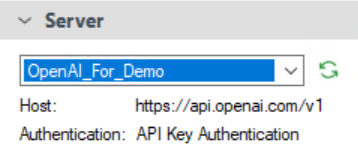
Input
Choose between Plain Text or Tokens in the drop-down menu.
Plain Text
Enter any text directly for translation. The content is sent exactly as written and processed as a single text block. Click the Token button (right arrow) ![]() to use tokens.
to use tokens.
Tokens
Provide a token that contains the text to be translated. The translated result is stored in a new token. These tokens can be used in other activities.
- Select New Token and enter the token content. A new dialog box will open.
- Assign a name to the token.
- Specify a value using the token selector
 .
. - (Optional) Select Output as multiple values if you want the translation returned as a set of values instead of a single string.

Language
Source: Specify the source language for best accuracy, or allow the system to detect the language automatically.
Target: Select the language you want to translate the text into.
Settings
Timeout: Increase the timeout value if the server or model responds slowly. This setting allows workflows to complete successfully even when using lower performance or local translation models. Click the Token button (right arrow) ![]() to use tokens.
to use tokens.
Test: Preview translation results before running the workflow. Testing verifies server connectivity, token mapping, and translation quality. If a token is used in the input prompt, testing will prompt for a Test Value to test with.
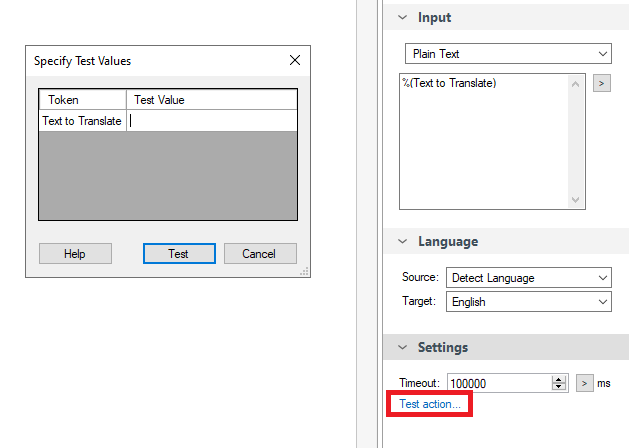
Advanced Settings
In the Advanced settings  , you can configure a custom glossary, specify a usage scenario, and adjust AI parameters to fine-tune translation output.
, you can configure a custom glossary, specify a usage scenario, and adjust AI parameters to fine-tune translation output.
Glossary
A Glossary is a customizable list of terms and their preferred translations that ensures consistency across documents processed by Laserfiche AI Translation. It’s especially useful for organizations that use specific terminology, such as department names, acronyms, or industry-specific phrases that need to be translated the same way every time.
You can create glossaries and reference them when configuring the AI Translation activity. When a glossary is attached, the translation engine will automatically substitute or preserve terms based on your defined rules, helping maintain brand, legal, or technical accuracy.
Note: By default, the glossary set within the web service is followed.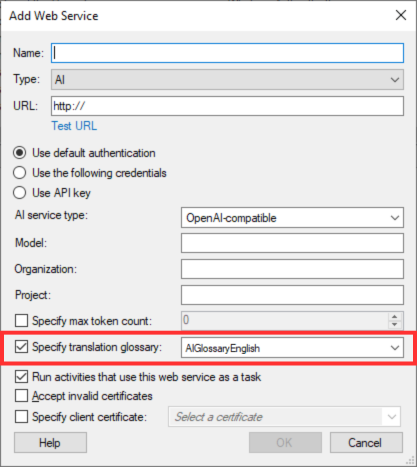
Type: JSON file
A JSON file is a structured glossary file that defines translation terms and their standardized equivalents.
Source
- Workflow Server local disk: A glossary file stored locally on the Workflow Server.
Click the Token button (right arrow) to use tokens or use the browse button
to use tokens or use the browse button  to choose a file.
to choose a file. - Server attachment: A glossary uploaded and attached to the server for reuse across workflows.
Select an attachment from the drop-down list or use the browse button to choose a file.
to choose a file. - Activity: A glossary generated or provided by another activity within the same workflow.
Use the browse button to choose a file.
to choose a file.
Type: Name-value pairs
Name-value pairs are a simple glossary format that lists each term and its corresponding translation value.
Select the Click here to configure the glossary box to configure name-value pairs. Click the Token button (right arrow) ![]() to use tokens.
to use tokens.
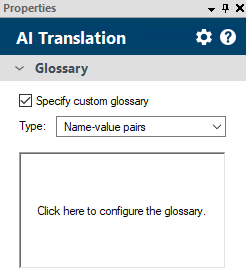
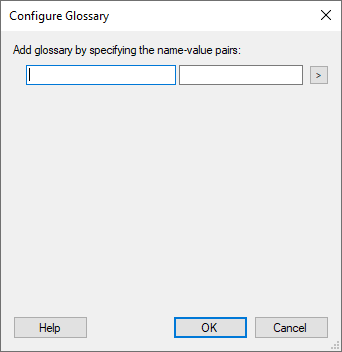
Usage Scenario
Selecting a usage scenario helps optimize translation style and terminology for different contexts.
- Not specified: Default general-purpose translation.
- Business software: Optimized for technical terminology, menus, and user interface text.
- Authoritative document: Produces formal, precise translation suitable for contracts or policy documents.
- Education: Generates clear, accessible translations tailored for students, teachers, and learning materials.
- Financial services: Ensures accurate use of financial and regulatory terms.
- Custom Scenario: Type in your own scenario for unique customization.
AI Settings
Temperature: Controls the variability of the translation. Lower values (closer to 0) produce more predictable and literal translations, while higher values (closer to 1) may generate more creative or paraphrased results. Click the Token button (right arrow) ![]() to use tokens.
to use tokens.
The AI Translation activity produces the following tokens.
| Name | Description | Sample Syntax |
|---|---|---|
| WasTranslated | Whether the AI Translation activity translated. The token can have one of two possible values: True or False. |
%(AITranslation_Was Translated) |
| Result | The translation result when input type is plain text. | (AITranslation_Result) |